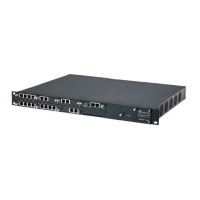Installation & Operation Manual 472 Document # LTRT-92224
Mediant 8000
38.6 Configuring the SS7 Subsystem
Signaling System #7 (SS7) is a global standard for telecommunications defined by the
ITU-T. The SS7 standard defines the procedures and protocols by which network
elements in the public switched telephone network (PSTN) exchange information over
a digital signaling network to effect wireless and wireline call setup, routing and
control.
The hardware and software functions of the SS7 protocol are divided into functional
abstractions called "levels". These levels are mapped to the OSI 7-layer model.
Figure
38-7: OSI Reference Model and SS7 Protocol Stack
SS7 messages are exchanged between network elements over bidirectional channels
called signaling data links. Signaling occurs out-of band on dedicated channels
rather than in-band on voice channels.
Each signaling point (node) in the SS7 network is uniquely identified by a numeric
point code. Point codes are carried in signaling messages exchanged between
signaling points to identify the source and destination of each message.
Each signaling point uses a routing table to select the appropriate signaling path for
each message. The collection of signaling links between two adjacent nodes is known
as linkset. The MTP3 automatically load shares between links within a linkset and re-
routes traffic to a working link within the same linkset on a detection of failure.
MTP3 is also able to load share between two linksets that serve the same destination
(through the use of intermediate nodes), the link sets here being contained within a
routeset.

